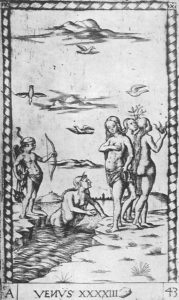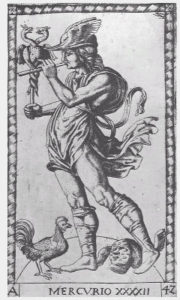What is the Mantegna Tarot?
It is quite entertaining to think that the so called “Mantegna Tarot” was not made by Mantegna, nor was it a tarot. With its directness and interactivity, it is a key in unveiling the wisdom of the Italian Renaissance, and making it applicable to our contemporary times in a direct manner. The Mantegna Tarot is based on 50 engravings, numbered from 1 to 50 and labelled from A to E (S, in another edition). Designed in Italy during the 15th century, influenced by the art of the Estensi Court in Ferrara, these engravings were copied and spread across Europe.
The Renaissance Mantegna Tarot: Structure
The Mantegna Tarot deck is very different in structure from other tarots. One can clearly see the many similarities among other Renaissance Tarot decks (Visconti Sforza Tarot, Sola Busca Tarot) and the more recent Tarot of Marseille, Rider-Waite Tarot, Thoth Tarot. The Mantegna Tarot does not have so similarities. It is made by 50 engravings. Each has a name, Roman number, group’s identifying letter, Arabic number. The themes are grouped into five numbered sequences: 1-10, 11-20, 21-30, 31-40, 41-50.
The Group E (1-10) covers the hierarchy of society:
1 Beggar (Miser)
2 Servant (Fameio)
3 Craftsman (Artixan)
4 Merchant (Merchant)
5 Gentleman (Zintilomo)
6 Knight (Chavalier)
7 Doge of Venice (Doxe)
8 King (Re)
9 Emperor (Emperor)
10 Pope (Papa)
The Group D (11-20), brings the nine Muses and Apollo. Group C (21-30), the seven liberal arts and Philosophy, Poetry, Theology . Group B (31-40): the Genius of the Sun (Iliaco), Genius of Time (Chronic), Genius of the world (Cosmic), and the Seven Virtues. Group A (41-50): the Sun, Moon, five traditional planets (Mercury, Venus, Mars, Jupiter, Saturn), the Eighth Sphere (Octava Spera) of the fixed stars, the Primo Mobile, and Prima Causa.
Group A includes our favorite couple:


You can use the Mantegna Tarot deck together with our EXSTATICA Self-Help Essentials: Unleash the Transformative Sparkles of the Renaissance Mantegna Tarot
The Renaissance Mantegna Tarot and Psychology
EXSTATICA is where the Tarot meets psychology and inner work. It uses the Mantegna Tarot to gain more insights about the Four Spheres of life: behavior, emotions, cognition, meaning. When we align these Spheres, for example using the Mantegna Tarot cards, we live a joyful life. Why? Because what matters for us – meaning – is the sphere where our cognitive resources are focused. Our cognition is supported by emotions, which makes it almost effortless to turn our meaning into behavior. This is a two way ladder. Our behavior brings emotions: often positive, sometimes negative, all giving us instant feedback, helping us to recenter ourself. Our emotions help our cognition, to expand its awareness of what our purpose is.
As mentioned above, the Mantegna Tarot was originally divided into five groups. EXSTATICA merges A (ultimate principles) and B (ethical principles) into the one Sphere of Meaning, because our life purpose includes both. Group C represents Cognition. Group D, Emotions. Group E, Behavior. EXSTATICA offers some key interpretations of each Mantegna Tarot card, and various spreads to use them, including the Triangle spread:
Are there other books about the Mantegna Tarot?
Yes. If you speak Spanish, I recommend El tarot de Mantegna. Availability of this and other Tarot books is variable.